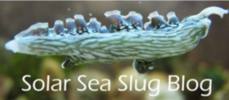Monthly Archives: November 2015


Good Algae Make Good Slugs
To possibly belabor a point, the limiting factor in slug husbandry seems to be food. So more, better food = more, better slugs?
Given how hard most aquarists work to eradicate nuisance algae, including the Bryopsis that Elysia clarki find irresistable, it would seem that growing algae should not be all that horribly challenging, right? One just needs good, strong light, plus some nutrients to support growth. The trick is to grow the species one wants, without having the cultures overtaken by undesirables. In my case, the “good” algae are Penicillus, Bryopsis, and, to a lesser extent, Derbesia, Halimeda, and Avrainvillea. The primary nuisance I am trying to avoid is “red slime” cyanobacteria, which can overtake and smother the other species.
Plants require nutrients such as carbon, nitrogen, potassium, and phosphorous in significant quantities, along with smaller amounts of calcium, magnesium and sulfur . Based on my measurements, the desirable algae consumed considerable amounts of nitrate, but adding phosphate did not appear to encourage growth target algae and increased the growth of cyanobacteria. So, along with calcium (Penicillus and Halimeda use it for structural support) and bicarbonate (a pH buffer and source of carbon) I have been using the dosing system to add potassium nitrate in order to maintain nitrate at about 5-10 ppm. For everthing else, I have been relying on the artificial seawater mix to provide an adequate balance. Perhaps not the most systematic approach to feeding the plants.
It has, however, worked reasonably well. In the photos above, there is a dense growth of Penicillus on the right side of the Broodstock tank, and a mat of Derbesia and Bryopsis on the left. The resident E. clarki seem quite happy to spend their days grazing without exhausting the supply. The other tanks are similarly productive. Nonetheless, it might be possible to increase algae productivity, thereby increasing slug capacity and the frequency of mating and egg laying.
There is, of course, an actual literature on the nutrient requirements of aquatic plants. Some commonly used formulas rely on extraction of nutrients from soil to provide the correct balance of elements. I might have tried that had I been able to buy the correct brand of English planting soil. However, based on a number of studies (Kumar et al., 2011 e.g.) Guillard’s f/2 medium (Guillard, 1975) yields excellent growth of macroalgae and does not require purchasing and soaking British soil.
Florida Aqua Farms supplies Guillard’s f/2 medium under the name “Plant Fuel,” providing pre-measured dry ingredients along with a suggested dosing regimen. Seemed worth a try to find out whether more complete supplementation will translate into faster growth of desirable algae. What’s the worst that can happen, aside from massive bloom of toxic, undesirable algae?
The components arrived, I mixed them up, and the dosing system is adding 1 ml of f/2 per 2.5 liters of system volume, distributed over the course of each week. We’ll see…


Getting Ready for Science
The project has had the feel of watching grass grow lately, mostly because I have been spending a lot of time collecting and establishing potential food algae for the slugs, and then watching them grow. Nonetheless, there is beginning to be some motion.
For example, starting Spring semester (late January), I will have a couple of students starting some simple molecular experiments. Although the diet of Elysia clarki is well-characterized, that of the species we find in Baja California, E. diomedea, is still not known for certain. On the next trip to Bahia de los Angeles, I plan to collect some E. diomedea, and identify their food plants based on the DNA of the chloroplasts that they have stolen from their food. This kind of work is straightforward in a comfortable lab where one has access to liquid nitrogen and other luxuries. However, we will need to develop protocols that will work in the heat and limited resources of the field station in Mexico. So, we will use the semester to develop a protocol for extracting and purifying DNA that utilizes the simplest methods possible. Meantime, it will be necessary to put together reading lists on the biology of Elysia and methods of DNA extraction so that we can hit the ground running.
The animal care system is also evolving. As I described a while ago, I have been lucky enough to get hefty samples of a few varieties of hair algae such as Bryopsis and Derbesia from local aquarists. The trick has been to get enough growth to maintain a self-sustaining supply of food. Although filling a tank with algae, sticking it into a window, and dumping hefty amounts of ammonia and phosphate into it produced decent results, it was not very stable.
Instead, I have added a 20 gallon tank devoted to growing algae to the slug culture system. The fancy hydroponics light gives a great spectrum for growth, but the strong red-pink quality of the light is not the most pleasing. There are a couple of species of hair algae, plus a tub of marine sand for macroalgae that need a substrate. To take advantage of the automated dosing of NO3, Ca and HCO3, it is plumbed into the rest of the system. Dosing of NO3 has already been increased a few times to keep up with the growth of the algae.
In other news, the controller that currently controls the lights, temperature and pH will soon be replaced by a newer, cloud-based model. This will allow remote monitoring of temperature, pH, and power use, as well as sensing moisture under the tanks in case of leaks. It can send email alerts in case of equipment failure, and should help prevent loss of animals or damage to property.





Recent Comments